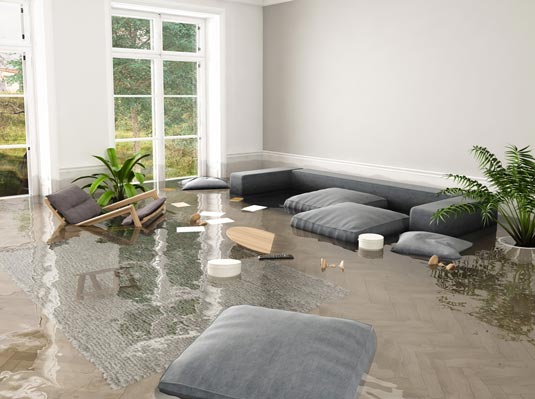
Here at Goosehead, we’ve never heard a client tell us they regret being overprepared for weather events. In most cases, taking a few extra precautions would have saved them time, headaches, and money. In this article, we’ll take you through some steps you can take ahead of a hurricane or flood to ensure you’re better prepared, as well as explain how to file a claim in the event you have damage from a weather event.
Preparation for a Hurricane or Flood
Step 1: Make a Family Emergency PlanTaking some time to develop a plan will help you avoid a state of panic when you know a hurricane is coming. A good plan should include somewhere safe you, your family, your pets, and any extended family in the area can go. If you live in a coastal area, find a location inland where you can stay if there is enough time to travel before the storm hits.
Now that you’ve established the evacuation plan, make sure you’ve also planned an emergency kit for your home so you have essential items on standby. FEMA has resources that can help you prepare, but in general, you want to make sure your emergency kit has the following items:
- Water (one gallon per person per day for at least three days, for drinking and sanitation)
- Food and a can opener (at least a three-day supply of non-perishable food for each member of your family, including babies and pets)
- Battery-powered or hand crank radio and a NOAA Weather Radio with tone alert
- Flashlight
- First aid kit
- Extra batteries
- Whistle (to signal for help)
- Dust mask (to help filter contaminated air)
- Plastic sheeting and duct tape (to shelter in place)
- Moist towelettes, garbage bags, and plastic ties (for personal sanitation)
- Local maps and paper copies of family documents and insurance documents
- Cell phone with chargers and a backup battery
- Any other personal needs like medications and changes of clothes
Step 2: Prepare Your Home
If you live in hurricane-prone area, there are actions you can take ahead of time to prepare your home, like cutting back trees and installing storm shutters. But if you only have a matter of days or hours, here are a few tasks that can help alleviate unnecessary damage when a storm or flooding hits:
- Move cars and any outdoor items into garages or higher ground
- Board up windows
- Safeguard important paperwork in a waterproof container
- Move your most valuable items and electronics off the floor or to an upper level of your home
- Clear debris from gutters so water flows where it’s supposed to
Step 3: Purchase Proper Homeowners Insurance Coverage
A strong hurricane may have heavy wind, tornadoes, rain, and flooding all at once. To be fully prepared, you’ll need to understand how insurance coverage works for each of these events.
- Strong Winds/Tornadoes: Most homeowners insurance policies include coverage for wind damage. If your home is in a coastal area, this coverage may look a little different on your policy than on a typical homeowners insurance policy. If you live on the coast, you’ll usually be provided wind coverage from hurricanes in one of three ways:
- A wind and hail deductible. If your home policy lists out only two deductibles, one for wind and hail, and one for all other perils, then you can assume that your wind and hail deductible is also what you will pay out for hurricane winds. This is the most standard way to receive coverage.
- A “Named Storm Deductible” or “Hurricane Deductible”. The closer you live to the coast, the more likely it is that you will see this third deductible listed. If your homeowners insurance policy displays a hurricane deductible, then damages that occur due to a hurricane or named storm will be subject to that deductible. Usually, that deductible is a higher amount than the wind and hail deductible on your policy.
- A separate wind policy. If you live in a beachfront property, chances are your home insurance policy doesn’t include any wind coverage. Due to the likelihood of hurricane damage, most carriers choose to simply stay away from the risk. Most homeowners on islands or beaches will need to purchase a separate wind policy. Many states have their own wind insurance program, such as Texas Windstorm Insurance Association, or TWIA. If you live in a coastal area, make sure you know exactly how much your deductible will be for wind damage, and talk to your agent to make sure you’re covered.
- Rain: When rain enters the home, it can create costly damage to your floors, walls, and personal belongings. Thankfully, most homeowners insurance policies will cover rain damage as long as the damage wasn’t the result of negligence, like leaving a window open during a storm. If rain water accumulates on the ground and then seeps into the home, that would be classified by most insurers as flooding and would not be covered by your home insurance policy (see next bullet).
- Flood: Almost all homeowners insurance policies exclude coverage from flood damage. You need a separate policy to cover flooding. Flood damage occurs when water on the ground flows into and damages your home. The FEMA definition of a flood is an excess of water on land that is normally dry. Flooding is very common with a hurricane, and a separate flood policy is needed to properly prepare for a big storm. Flood insurance through the National Flood Insurance Program has a wait period of 30 days between purchase and when the policy becomes effective, so be sure to secure it ASAP so that you aren’t caught without coverage when a storm comes.
Recovering from a Hurricane or Flood
Dealing with the aftermath of a hurricane or flood can be challenging, but there are some clear steps you can follow to get through the process.Step 1: Take Action Quickly
Acting quickly when you have damage can save thousands of dollars, so try to mitigate any more water coming into the home. Contact a local water restoration service to start to eliminate the water and anything that it has touched. They will also dry out the home in preparation for the repairs to be done. Don’t forget to keep receipts from any immediate work that has to be done that first day. Your insurance provider wants you to minimize the damage from the water, but they also want to see documentation of what happened and what (if anything) was paid to minimize the damage.
Step 2: File a Claim
Whenever there is a hurricane or flood, there will be hundreds, sometimes thousands of people who need help at the same time. It’s important that you make your insurance provider aware of your loss as soon as possible so that the claims process can begin. Thankfully, most insurance providers will pull claims adjusters and resources from other parts of the country to help support a faster process after a hurricane, but it’s still going to take a while, so get on the top of their list. Any damage caused to your vehicles can also be claimed under your car insurance policy at this time.
Step 3: Document
Take pictures of everything that was damaged and make a list of all of the things you have lost. Keep a record of expenses that you are incurring as a result of the storm. Most home insurance policies will cover the cost of a rental home or a hotel room if the home is not habitable. Make your adjuster aware that you can’t stay at your home so they can help you secure lodging. Keep a record of all receipts during this time so that you can maximize your benefits through the insurance provider.
Step 4: Communicate
Stay in close contact with both your agent and your claims adjuster while they assess the damages, review coverages, and work to repair your home. The main reason for a slower claims process or a bad experience is typically due to lack of communication. Send your documentation quickly and communicate via phone or email often, and the process will go much smoother for everyone involved.
If you’re a Goosehead client and you are experiencing the aftermath of a hurricane or flood, our Service team is ready to help. Visit our Contact Us page to learn the ways you can interact with Service and make a claim.
The contents of this article are for informational purposes only. You should not act or refrain from acting based on this information without first consulting a Goosehead licensed agent. We disclaim all liability for actions taken or not taken by you based on the contents of this article which is provided "as is." Goosehead makes no representation that this content is error-free.

